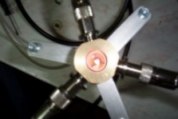Plasma sources for spectrochemistry
Despite the argon ICP has proven to be the most useful and widely applied source for plasma OES and MS, alternative plasma sources are extensively investigated, including different plasma gases as well as frequencies. The helium MIP is an attractive alternative to an ICP as a source for detection of trace nonmetals and metalloids in natural samples. Application of MIP in spectrometric techniques have led to development of different microwave plasma cavities capable of generating plasmas at atmospheric as well as reduced pressure.

Sample introduction techniques for plasma spectrometry
Sample introduction techniques persist as the „Achilles heel” in the plasma spectrometry instrumentation. Pneumatic and ultrasonic nebulization is widely developed for generation of liquid aerosols. Micronebulizers, operating at sub-mililiter range of sample flow rates, presents potential benefits compared to conventional nebulizers including much higher analyte transport efficiency into the plasma. Continuous powder introduction is a newly developed solid sampling technique based on pneumatic nebulization.

Plasma diagnostics
Plasma diagnostics is a useful tool for examination of new instrumentation approaches and new concepts of sample presentation into the plasma. Based on the fundamental studies new analytical applications of plasma techniques could be successfully predicted in the environmental and industrial area.


